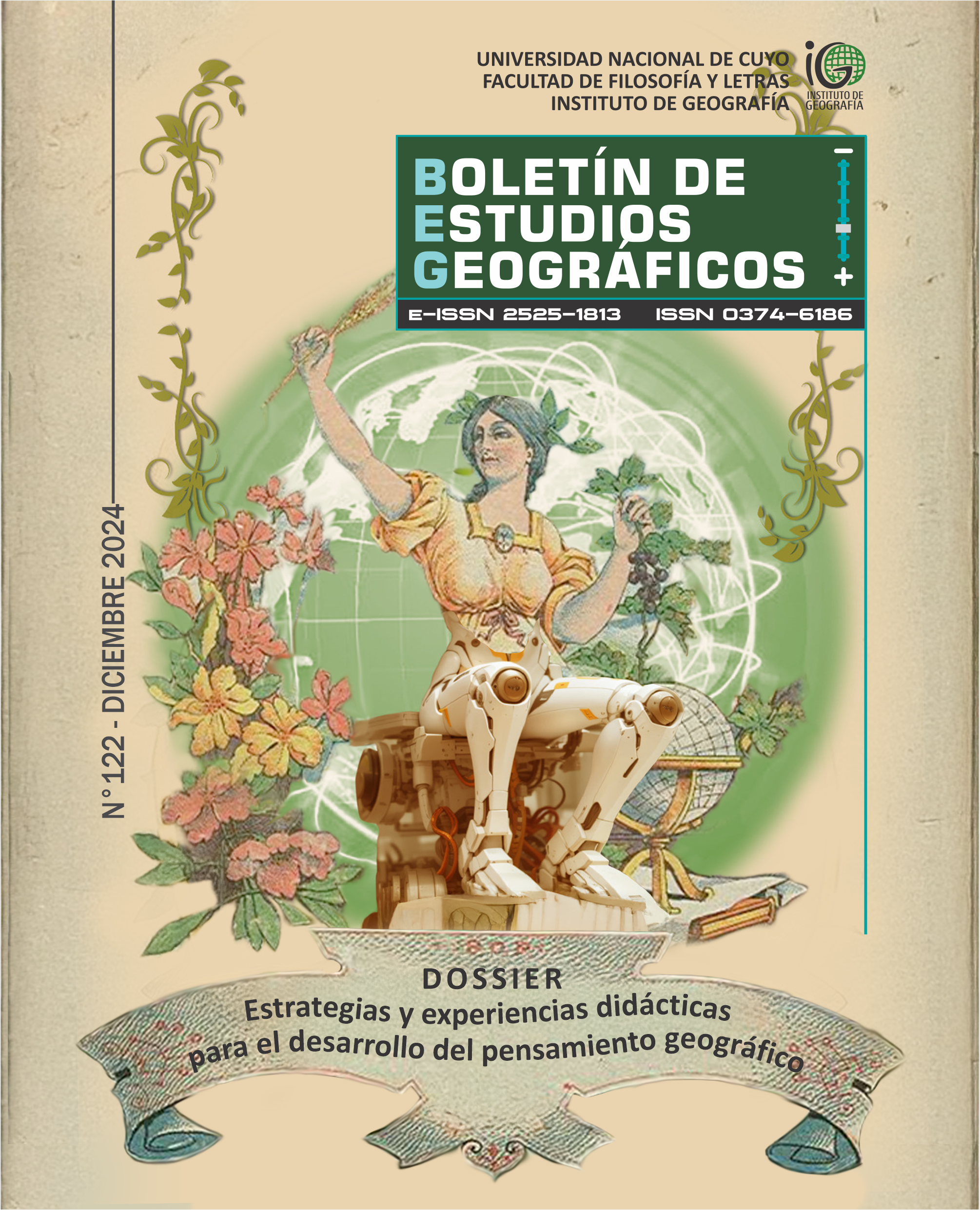Using Mobile Phones Through the Flipped Classroom in High School Geography Course
DOI:
https://doi.org/10.48162/rev.40.052Keywords:
Mobile phone, flipped classroom, geography and upper secondary educationAbstract
The general objective of this mixed study is to analyze the use of mobile phones outside the classroom during Unit 1 “Changing and dynamic society” of the geography course, integrating the flipped classroom model. The results of this research indicate that the use of mobile phones positively influences the autonomy and enthusiasm of students. In addition, various benefits are evident in the teaching-learning process of Geography, such as improved communication, searching for information, conducting research, understanding school subjects, resolving doubts, obtaining new information and easy access to web pages. In conclusion, mobile phones are technological devices that support the teaching-learning process on geography. In addition, the flexibility of time and space of these devices encourages personalized learning through the consultation and use of school content.
References
Ananto, P. y Ningsih, S. K. (2020). Incorporation of Smartphones and Social Media to Promote Mobile Learning in an Indonesian Vocational Higher Education Setting. International Journal of Interactive Mobile Technologies, 14(19), 66-81. https://doi.org/10.3991/ijim.v14i19.13863
Barratt-Pugh, C., Hill, S. y Johnson, N. F. (2024). Designing and Implementing a Family Literacy Program Through Smartphones: How Does Recruitment Method Influence Uptake and Attrition? Early Childhood Education Journal, 52, 345-356. https://doi.org/10.1007/s10643-022-01433-z
Chimmalee, B. y Anupan, A. (2023). The effects of using flipped cloud learning with advancing mathematical thinking approaches on undergraduate students’ mathematical critical thinking. Turkish Online Journal of Distance Education, 24(3), 240-260. https://doi.org/10.17718/tojde.1125894
Guevara-Otero, N., Cuevas-Molano, E., Vargas-Perez, A. M. y Sánchez Rivera, M. T. (2024). Evaluating face-to-face and online flipped learning on performance and satisfaction in marketing and communication students. Contemporary Educational Technology, 16(1), ep490. https://doi.org/10.30935/cedtech/14100
Hartley, K., Shreve, E., Gianoutsos, D. y Bendixen, L. D. (2022). The Smartphone as a Self-regulatory Planning Tool: Promise or Peril. International Journal of Interactive Mobile Technologies, 16(14), 78-92. https://doi.org/10.3991/ijim.v16i14.28783
Hefter, M. H. (2023). Web-Based Training and the Roles of Self-Explaining, Mental Effort, and Smartphone Usage. Technology, Knowledge and Learning, 28, 1079-1094. https://doi.org/10.1007/s10758-021-09563-w
Hochberg, K., Becker, S. y Louis, M. (2020). Using Smartphones as Experimental Tools—a Follow-up: Cognitive Effects by Video Analysis and Reduction of Cognitive Load by Multiple Representations. Journal of Science Education and Technology, 29, 303-317. https://doi.org/10.1007/s10956-020-09816-w
Huey, M. y Giguere, D. (2023). The Impact of Smartphone Use on Course Comprehension and Psychological Well-Being in the College Classroom. Innovative Higher Education, 48, 527-537. https://doi.org/10.1007/s10755-022-09638-1
Jabali, O., Saeedi, M. y Shbeitah, G. (2019). Medical faculty members’ perception of smartphones as an educational tool. BMC Medical Education, 19, 264. https://doi.org/10.1186/s12909-019-1697-5
Junaid, S. M., Jamil, B. y Khan, M. A. (2023). Smartphone as an educational tool” the perception of dental faculty members of all the dental colleges of Khyber Pakhtunkhwa - Pakistan. BMC Medical Education, 23, 122. https://doi.org/10.1186/s12909-023-04093-8
Keskin, D. (2023). Implementation of flipped model in EFL reading classrooms. Turkish Online Journal of Distance Education, 24(3), 261-279. https://doi.org/10.17718/tojde.1132888
López-Noguero, F., Romero-Díaz, T. y Gallardo-López, J. A. (2023). Smartphone como herramienta de enseñanza-aprendizaje en educación superior en Nicaragua. Revista Iberoamericana de Educación a Distancia, 26(1), 307-330. https://doi.org/10.5944/ried.26.1.34016
Martín-Ramos, P., Ramos Silva, M. y Pereira da Silva, P. S. (2017). El teléfono inteligente en la enseñanza de las Leyes de la Física: movimiento de proyectiles. Revista Iberoamericana de Educación a Distancia, 20(2), 213-231. https://doi.org/10.5944/ried.20.2.17663
Noguera-Fructuoso, I., Robalino-Guerra, P. E. y Ahmedi, S. (2023). La flexibilidad del aula invertida para el diseño de escenarios de aprendizaje mediados y autorregulados. Revista Iberoamericana de Educación a Distancia, 26(2), 155-173. https://doi.org/10.5944/ried.26.2.36035
Ozkaraman, A., Kersu, O., Uzgor, F. y Cakirli, M., (2024). Development of mobile educational material for nurses: a process improvement study. Turkish Online Journal of Distance Education, 25(1), 273-288. https://doi.org/10.17718/tojde.1221102
Palmquist, A. (2023). Design Elements of Conflict: A Design Study of a Gamified Smartphone Application for Employee Onboarding. Technology, Knowledge and Learning, 28, 1133-1173. https://doi.org/10.1007/s10758-023-09657-7
Peechapol, C., Na-Songkhla, J., Sujiva, S. y Luangsodsai, A. (2018). Development of Smartphone Application Based on the Theory of Planned Behaviour to Enhance Self-Efficacy for Online Learning. International Journal of Interactive Mobile Technologies, 12(4), 135-151. https://doi.org/10.3991/ijim.v12i4.8715
Salas-Rueda, R.-A., Ramírez-Ortega, J., Martínez-Ramírez, S. M. y Alvarado-Zamorano, C. (2023). Uso de los algoritmos Machine Learning para analizar Moodle y los teléfonos inteligentes en el proceso educativo de la Física. Texto Livre, 16, e41293.
Salas-Rueda, R. A., Ramírez-Ortega, J., Eslava-Cervantes, A. L., Castañeda-Martínez, R. y De-La-Cruz-Martínez, G. (2022). Percepción de los profesores sobre los juegos web y dispositivos móviles en el nivel educativo superior durante la pandemia COVID-19. Texto Livre, 15, e37074. https://doi.org/10.35699/1983-3652.2022.37074
Sandobal-Verón, V. C., Marín, B. y Barrios, T. H. (2021). El aula invertida como estrategia didáctica para la generación de competencias: una revisión sistemática. Revista Iberoamericana de Educación a Distancia, 24(2), 285-308. https://doi.org/10.5944/ried.24.2.29027
Sarker, M. F. H., Rahman, S. M., Ahmed, S., Sifullah, M. K., Sohel, M. S., Akber, M. F. y Lia, S. M. (2023). Academic Use of Smartphones in Secondary Level Education in Bangladesh: A Non-Parametric Approach. International Journal of Interactive Mobile Technologies, 17(24), 96-114. https://doi.org/10.3991/ijim.v17i24.41231
Yasan-Ak, N., y Yildirim, S. (2024). An Investigation into Smartphone Use of Undergraduate Students in the Academic Environment and Its Predictors. Technology, Knowledge and Learning, 29, 963-995. https://doi.org/10.1007/s10758-023-09723-0
Yoon, M., y Yun, H. (2023). Relationships between adolescent smartphone usage patterns, achievement goals, and academic achievement. Asia Pacific Education Review, 24, 13-23. https://doi.org/10.1007/s12564-021-09718-5
Downloads
Published
How to Cite
Issue
Section
License

This work is licensed under a Creative Commons Attribution-NonCommercial 4.0 International License.



































